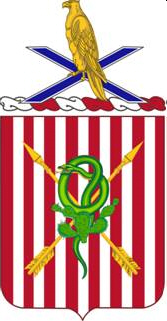2nd Regiment of Artillery
| 2nd Air Defense Artillery Regiment | |
|---|---|
 |
|
| Active | 1821 |
| Country | United States |
| Branch | Army |
| Type | Air defense artillery |
| Motto(s) | Fidus Ultra Finem (Faithful Beyond the End) |
| Engagements |
War of 1812 Indian Wars Mexican War U.S. Civil War World War II Vietnam War Southwest Asia |
| Commanders | |
| Notable commanders |
Brevet Lt Col. John Trout Greble |
| Insignia | |
| Distinctive unit insignia |  |
The 2nd Air Defense Artillery Regiment is an air defense artillery regiment of the United States Army first formed in 1821 as a field artillery unit.
Battery A-2 THAAD (Battery A, 2nd Air Defense Artillery Regiment, Terminal High Altitude Area Defense) of the 11th Air Defense Artillery Brigade (United States) successfully intercepted an Intermediate Range Ballistic Missile which was launched near Hawaii on 11 July 2017. The soldiers used the procedures of an actual combat scenario at the Pacific Spaceport on Kodiak Island, Alaska, and were not aware of the IRBM's launch time.
Constituted 1 June 1821 in the Regular Army as the 2nd Regiment of Artillery and organized from existing units with headquarters at Baltimore, Maryland.
2nd U.S. Artillery took part with distinction in the Mexican War and U.S. Army captain James Duncan received three brevets—major, lieutenant-colonel, and colonel—for his actions in the war.
Regiment was broken up on 13 February 1901, and its elements reorganized and redesignated as separate numbered companies and batteries of the Artillery Corps.
Reconstituted 1 July 1924 in the Regular Army as the 2nd Coast Artillery at Fort Sherman in the Harbor Defenses of Cristobal (Batteries E, G, and H concurrently reorganized and redesignated from existing units in the Panama Canal Zone). The regiment was organized by redesignating the 13th, 14th, 15th, 16th, 18th, 19th, 20th, 21st, 22nd, 23rd, and 24th companies of the Coast Artillery Corps (CAC). Batteries B, C, D, E, H, I, K, and L carried the lineage and designations of the corresponding batteries in the old 2nd Artillery.
(Battery C activated 30 April 1926 in the Canal Zone; Battery G concurrently inactivated in the Canal Zone. Batteries C, E, and H inactivated 15 April 1932 in the Canal Zone and transferred, less personnel and equipment, to Fort Monroe).
...
Wikipedia
